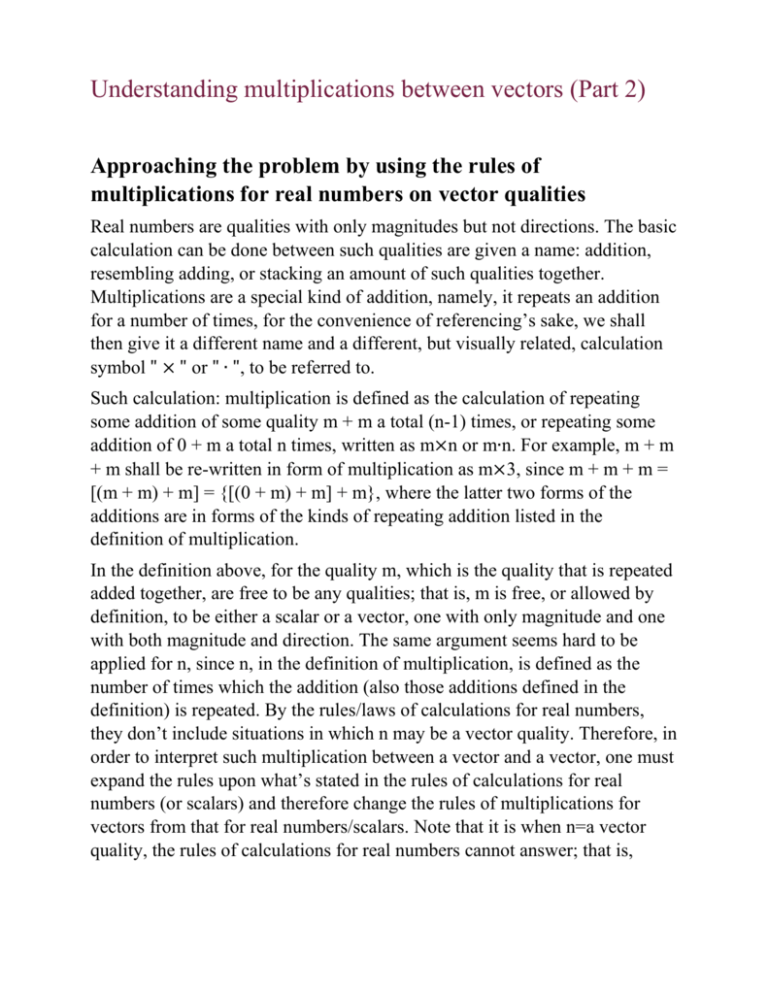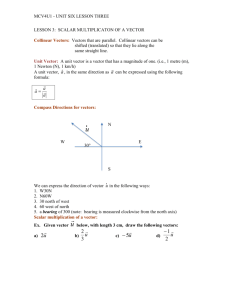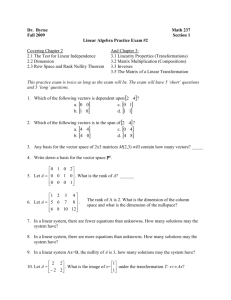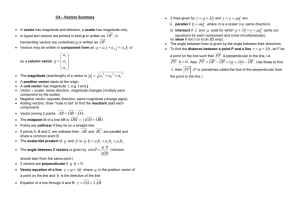When a scalar multiplies a vector, a quality with only magnitude and
advertisement

Understanding multiplications between vectors (Part 2)
Approaching the problem by using the rules of
multiplications for real numbers on vector qualities
Real numbers are qualities with only magnitudes but not directions. The basic
calculation can be done between such qualities are given a name: addition,
resembling adding, or stacking an amount of such qualities together.
Multiplications are a special kind of addition, namely, it repeats an addition
for a number of times, for the convenience of referencing’s sake, we shall
then give it a different name and a different, but visually related, calculation
symbol " × " or " ∙ ", to be referred to.
Such calculation: multiplication is defined as the calculation of repeating
some addition of some quality m + m a total (n-1) times, or repeating some
addition of 0 + m a total n times, written as m×n or m∙n. For example, m + m
+ m shall be re-written in form of multiplication as m×3, since m + m + m =
[(m + m) + m] = {[(0 + m) + m] + m}, where the latter two forms of the
additions are in forms of the kinds of repeating addition listed in the
definition of multiplication.
In the definition above, for the quality m, which is the quality that is repeated
added together, are free to be any qualities; that is, m is free, or allowed by
definition, to be either a scalar or a vector, one with only magnitude and one
with both magnitude and direction. The same argument seems hard to be
applied for n, since n, in the definition of multiplication, is defined as the
number of times which the addition (also those additions defined in the
definition) is repeated. By the rules/laws of calculations for real numbers,
they don’t include situations in which n may be a vector quality. Therefore, in
order to interpret such multiplication between a vector and a vector, one must
expand the rules upon what’s stated in the rules of calculations for real
numbers (or scalars) and therefore change the rules of multiplications for
vectors from that for real numbers/scalars. Note that it is when n=a vector
quality, the rules of calculations for real numbers cannot answer; that is,
when n is a real number, such rules for calculations of real numbers are
capable of calculating a real number, or a scalar multiply a vector, as where
m shall a vector quality and n shall the real number, or scalar.
Studying the behavior of two vectors in multiplications by
deriving it from the behaviors observed in situations which
the rules of calculations for scalars allow
To study how multiplication of vectors would behave, we shall then study in
general about how the two characteristics of vectors, or any qualities in
general: magnitudes and directions, would behave when involved in such
calculations.
According to the rules of calculations for scalars, we are able to interpret how
the qualities behave when scalar multiplies scalar and scalar multiplies
vector.
When a scalar multiplies a scalar, two qualities both with only magnitudes
but no directions are multiplied together, the calculation results in a change of
only magnitudes that changes the qualities according to the rules of
calculations for scalars, but no change can be observed in the directions of
both qualities. The qualities that are multiplied and the resultant qualities all
still only magnitudes and no directions.
When a scalar multiplies a vector, a quality with only magnitude and no
direction multiplies a quality with both magnitude and direction, we observe
that the result of such calculation shows only changes in the magnitude of the
qualities, while the direction of the resultant quality exists, and remains to be
the same direction as the direction of the vector multiplied.
Observing from the situations above which are situations allowed, or capable
of interpreting using rules of calculations for scalars, we are able to conclude
few fundamental behaviors of magnitudes and directions of qualities:
1. In both situations, the magnitude of one quality is unable to have any
affect on the direction of the other quality, and vice versa.
2. Direction of one quality is unable to be produced by any multiplications
of only magnitudes, and it remains the same during the calculation,
since the magnitude of the other quality is unable to affect it.
2
In short and conclusion, magnitude can only affect magnitude, direction can
only affect direction, as those of some qualities.
Deriving from the conclusion above, for the multiplication of a vector and a
vector, that is, two qualities with both magnitudes and directions, one would
expect, according to the pattern observed and discussed above, the extra
direction (comparing to the multiplication between a scalar and a vector) of
one of the two vectors would only affect the direction of the other vector,
while the magnitude of one vector shall only affect the magnitude of the other
vector, as it is the same in the multiplication between scalar and vector, such
multiplication between two magnitudes would then simply behave the same
as the multiplication between two scalars. Therefore, to find the result of the
multiplication of two vectors, one needs to know how direction affects
direction in multiplication of them.
The conflicts between behaviors of characteristics of vectors
in definition of addition of vectors and in rules of
calculations for scalars
The addition of vectors, from which the multiplication of vectors is derived,
alike the multiplication for vectors, is separated, or expanded defined from
that calculation for real numbers, or scalars.
In the geometric approach, the addition of vectors and the object vector itself
is so defined solely for creating a model that corresponds to behaviors of
similar objects in our world for one’s purpose to interpret behaviors of those
object in the world in a fundamental and systematic approach. That is, from a
geometric approach’s point of view, the addition of vectors is arbitrarily
defined so that the rules of addition of vectors satisfy patterns of behaviors
which are observed in our world; in other words, vector is a model with sets
of defined objects and rules, such model is defined, or designed to simulate
the behaviors of objects in the world to understand and interpret them. In
short, vector itself and the addition of vectors are not strictly derived from
rules of calculations for scalars, but defined so that the model consists of the
object vectors and rules which they operate on would operate in the similar
way (or the perfect way as our ultimate goal for creating such model) to those
objects around in our world.
3
This argument can also be easily seen by comparing the rules of addition for
vectors and that for scalars. In the rules of addition for vectors, it must define
the behaviors of both the magnitudes and the directions of the qualities added
together. In the rules of addition for scalars, it defines the behaviors for
magnitudes of qualities added together while the behaviors for the directions
of them are unknown in such calculation, since such calculation is defined for
qualities with only magnitudes.
As shown in the above arguments, since the rules of addition for vectors is
not derived from that for scalars but defined in certain ways for one’s purpose
to create interpretable model, one shall expect, or deduce further that, for
rules of multiplication for vectors, as multiplication is a separated defined
special types of additions, is derived upon the rules of addition for vectors
and thus the behaviors of the qualities would follow the same as what’s
described in the rules of addition for vectors. In short and conclusion, since
the rules of addition for vectors is separated defined for one’s purpose of
creating a model, but is not defined upon the rule of addition for scalars, and
since the rules of multiplication for vectors is derived and constructed upon
the rule of addition for vectors, one shall expect and deduce that the rules of
multiplication for vectors, alike the rules of addition for vectors, follows
different, separated defined principles from those in the rules of calculations
for scalars. Therefore, the rules of multiplication for vectors cannot as it is
not intended to, be derived from the rules of calculations for scalars. The
rules of multiplication for vectors, derived and defined upon the rules of
addition for vectors, alike the rules of addition for vectors, is defined for
one’s purpose to create a model that simulates the behaviors of certain
objects for studying.
4





